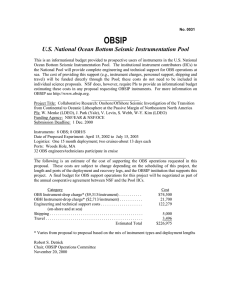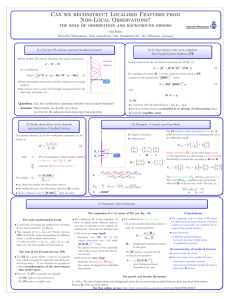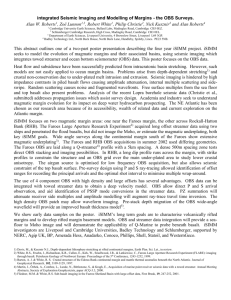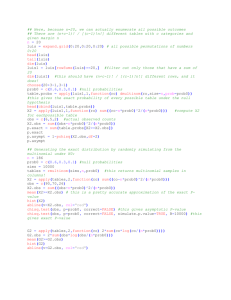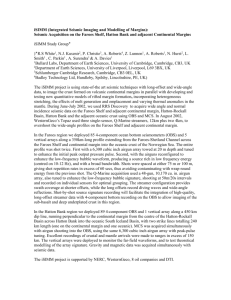L - Istituto Nazionale di Oceanografia e di Geofisica Sperimentale
advertisement
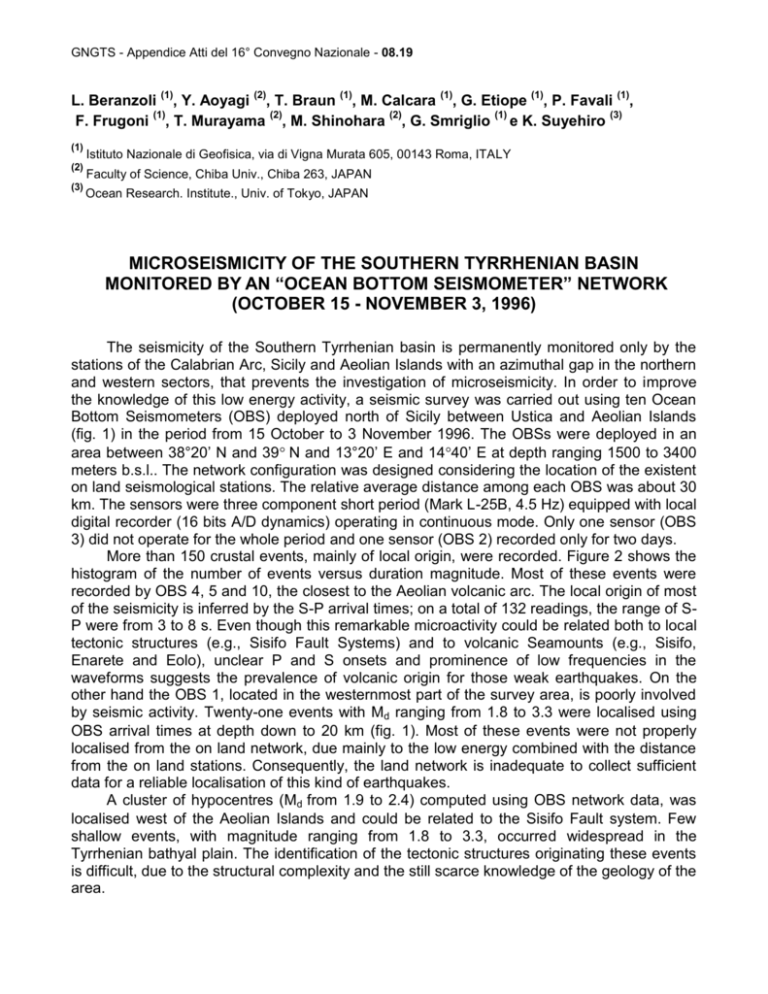
GNGTS - Appendice Atti del 16° Convegno Nazionale - 08.19 (1) (2) (1) (1) (1) (1) L. Beranzoli , Y. Aoyagi , T. Braun , M. Calcara , G. Etiope , P. Favali , F. Frugoni (1), T. Murayama (2), M. Shinohara (2), G. Smriglio (1) e K. Suyehiro (3) (1) (2) (3) Istituto Nazionale di Geofisica, via di Vigna Murata 605, 00143 Roma, ITALY Faculty of Science, Chiba Univ., Chiba 263, JAPAN Ocean Research. Institute., Univ. of Tokyo, JAPAN MICROSEISMICITY OF THE SOUTHERN TYRRHENIAN BASIN MONITORED BY AN “OCEAN BOTTOM SEISMOMETER” NETWORK (OCTOBER 15 - NOVEMBER 3, 1996) The seismicity of the Southern Tyrrhenian basin is permanently monitored only by the stations of the Calabrian Arc, Sicily and Aeolian Islands with an azimuthal gap in the northern and western sectors, that prevents the investigation of microseismicity. In order to improve the knowledge of this low energy activity, a seismic survey was carried out using ten Ocean Bottom Seismometers (OBS) deployed north of Sicily between Ustica and Aeolian Islands (fig. 1) in the period from 15 October to 3 November 1996. The OBSs were deployed in an area between 38°20’ N and 39N and 13°20’ E and 1440’ E at depth ranging 1500 to 3400 meters b.s.l.. The network configuration was designed considering the location of the existent on land seismological stations. The relative average distance among each OBS was about 30 km. The sensors were three component short period (Mark L-25B, 4.5 Hz) equipped with local digital recorder (16 bits A/D dynamics) operating in continuous mode. Only one sensor (OBS 3) did not operate for the whole period and one sensor (OBS 2) recorded only for two days. More than 150 crustal events, mainly of local origin, were recorded. Figure 2 shows the histogram of the number of events versus duration magnitude. Most of these events were recorded by OBS 4, 5 and 10, the closest to the Aeolian volcanic arc. The local origin of most of the seismicity is inferred by the S-P arrival times; on a total of 132 readings, the range of SP were from 3 to 8 s. Even though this remarkable microactivity could be related both to local tectonic structures (e.g., Sisifo Fault Systems) and to volcanic Seamounts (e.g., Sisifo, Enarete and Eolo), unclear P and S onsets and prominence of low frequencies in the waveforms suggests the prevalence of volcanic origin for those weak earthquakes. On the other hand the OBS 1, located in the westernmost part of the survey area, is poorly involved by seismic activity. Twenty-one events with Md ranging from 1.8 to 3.3 were localised using OBS arrival times at depth down to 20 km (fig. 1). Most of these events were not properly localised from the on land network, due mainly to the low energy combined with the distance from the on land stations. Consequently, the land network is inadequate to collect sufficient data for a reliable localisation of this kind of earthquakes. A cluster of hypocentres (Md from 1.9 to 2.4) computed using OBS network data, was localised west of the Aeolian Islands and could be related to the Sisifo Fault system. Few shallow events, with magnitude ranging from 1.8 to 3.3, occurred widespread in the Tyrrhenian bathyal plain. The identification of the tectonic structures originating these events is difficult, due to the structural complexity and the still scarce knowledge of the geology of the area. The OBS survey has demonstrated that in the Tyrrhenian bathyal plain a seismic activity takes place with an energy release higher than that in the Aeolian Islands Arc. Finally, based on the fact that the low magnitude events are systematically undetected if the monitoring is performed by land stations only, the OBS seismic network revealed to be a very useful tool to cover and to fill most of the limitations supplied by the on-land networks. Fig. 1 - Location of the ten OBSs used in the seismic survey (circles with number) and local seismic events localised by the array (black triangles). Si=Sisifo Seamount; En=Enarete Seamount; Eo=Eolo Seamount. Equidistance 400 mt. Fig. 2 - Histogram of number of local events detected by the OBSs array versus duration magnitude. (Text controlled by Prof. Ignazio Guerra)

